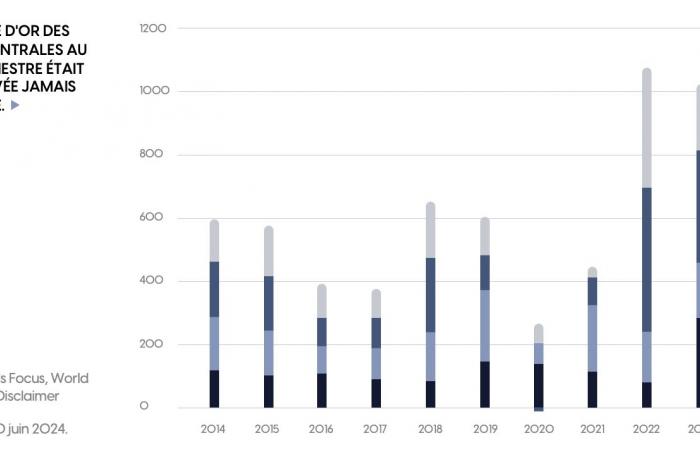One of the main reasons for this gold rush is the growing loss of confidence in the US dollar.
In recent years, a striking trend has emerged in global financial markets: central banks, particularly those of the BRICS (Brazil, Russia, India, China and South Africa), have accelerated their purchases of gold, culminating in 2024 with record purchases. This strategy reflects a major change in the management of international reserves. Once dependent on the US dollar and government bonds, these institutions are increasingly turning to gold to protect against currency devaluation and geopolitical risks.
One of the main reasons for this gold rush is the growing loss of confidence in the US dollar. Once the world’s reserve currency, the dollar is seeing its role gradually called into question. The petrodollar agreement, which historically linked the dollar to oil transactions, is unraveling. Saudi Arabia, one of the largest oil producers, has increased its gold reserves, signaling a shift to trading in currencies other than the dollar, weakening the greenback’s dominance in global trade.
BRICS and the growing demand for gold
China, one of the world’s major economic powers, has stepped up its gold purchases in response to growing tensions with the United States and dollar instability. India and Russia, also BRICS members, followed this strategy, increasing their gold reserves to diversify their holdings and protect against currency fluctuations. These countries seek to limit their exposure to the dollar and strengthen their economic resilience in an uncertain global context.
In 2024, global demand for gold reached nearly 4,740 tonnes, marking a significant increase, and a good part of this demand comes from BRICS central banks. China acquired over 100 tonnes of additional gold in the first half of 2024 alone. Furthermore, according to the World Gold Council, India also increased its gold reserves by 70 tonnes that year, reflecting soaring demand among the world’s major economies.
Current geopolitical tensions, including the conflict between Ukraine and Russia, as well as rising tensions between Iran and Israel, are increasing demand for safe assets like the yellow metal.
Geopolitical factors and buying frenzy
Gold purchases are not solely motivated by economic reasons. The geopolitical context plays a key role. Russia, under severe economic sanctions, has increased its gold reserves to circumvent the use of the dollar and protect its economy. Gold, which is not directly affected by exchange rate fluctuations, has become a safe haven for these stability-seeking nations.
Current geopolitical tensions, including the conflict between Ukraine and Russia, as well as rising tensions between Iran and Israel, are increasing demand for safe assets like the yellow metal.
At the same time, countries like China and Russia are reducing their holdings of US Treasuries, preferring to redirect their reserves towards gold and other physical assets. By 2023, the share of U.S. Treasuries in global foreign exchange reserves has fallen to 59%, from 65% a decade earlier.
Portfolio diversification and the role of gold
Gold is no longer just a reserve asset. It has become a strategic tool for central banks and private investors. During periods of stock market volatility, gold often outperforms bonds, making it an effective hedge against economic risks. According to a Bloomberg study, a portfolio composed of 20% gold would have generated 8% higher returns compared to traditional bond-based portfolios.
Private investors are also following this trend by increasing their exposure to gold, both in physical form (jewelry, bars) and through financial instruments such as ETFs. Central banks and individuals are seeking to hedge against market volatility, a factor that explains the strong demand for gold-backed ETFs. Despite growing physical demand in Asia, financial flows through ETFs in the West have shown signs of slowing.
China, India and Poland: leaders in the purchase of gold
Asian markets, notably China and India, now dominate global demand for gold. In 2023, China purchased nearly 500 tonnes of gold, marking an increase of 14% from the previous year. India, which remains one of the world’s largest consumers of gold jewelry, has also stepped up purchases to protect against inflation.
Poland, meanwhile, has emerged as an important player in Europe. In 2023, the Central Bank of Poland increased its gold reserves by 120 tons, a strong signal that even developed economies see gold as a hedge against the devaluation of major currencies and economic uncertainties.







